Do humans have blue blood?
Safiya Zaloum
There are many reasons why you might think that humans have blue blood. On biology diagrams we are shown oxygenated blood in red and deoxygenated blood in blue. You might have seen a picture of the blood going into the lungs coloured bright blue and the blood leaving them bright red, having deposited the carbon dioxide and picked up oxygen. If you look down at the insides of your arms, you might be able to see your veins faintly through your skin. They might look green or blue or even purple, so surely the blood inside your veins is blue too?
Humans don’t actually have blue blood, whether the blood is deoxygenated, after the red blood cells have delivered the oxygen to the organs and tissues or whether it is oxygenated, no blood is blue, and it doesn’t change colour in between. Blood is always red, inside or outside of the body with oxygenated blood appearing a brighter red, and deoxygenated blood a darker red.
How do we see colours?
The human eye can see about 10 million different shades of colour! At the back of our eye we have our retina, which is responsible for detecting the light that we see. The retina contains two different types of cells to help us see – rods and cones. Cones are the ones that detect colour and we have 3 types of cones: ones that detect red, ones that detect green and ones that detect blue. Whenever you see something, each of these cones sends a signal to your brain telling it how much of its colour it has detected.
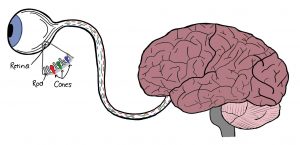
You might be wondering how we can see colours other than red, green and blue if our cones only detect these colours. If we were to see something yellow, a sunflower for example, then the red and green cones would be activated, as yellow is close to red and green. These signals will be sent to your brain which are interpreted as yellow.
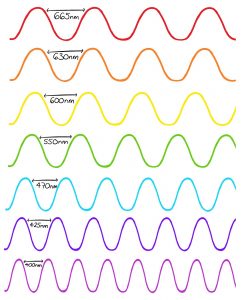 It is important to understand that all colours are seen as light waves. However, they belong to a larger group of waves, with visible light (the colours you see) in the middle. This is called the electromagnetic spectrum. At the end of the electromagnetic spectrum, there are radio waves which are used for things like broadcasting programmes on television and radio. The wavelengths of radio waves are super long – about the length of a tall building! At the small end of the spectrum, with a wavelength as small as an atom, there are x-rays which are used to x-ray broken bones in hospitals. Beyond this, there are gamma rays which are even smaller.
It is important to understand that all colours are seen as light waves. However, they belong to a larger group of waves, with visible light (the colours you see) in the middle. This is called the electromagnetic spectrum. At the end of the electromagnetic spectrum, there are radio waves which are used for things like broadcasting programmes on television and radio. The wavelengths of radio waves are super long – about the length of a tall building! At the small end of the spectrum, with a wavelength as small as an atom, there are x-rays which are used to x-ray broken bones in hospitals. Beyond this, there are gamma rays which are even smaller.
In the middle of the electromagnetic spectrum there is the light that we see. White light isn’t actually white, but is a mixture of all of the different colours that we can see, from red to purple. All of the different colours have different wavelengths, with red having the longest and purple having the shortest, with the other colours in between. It is these wavelengths that the cones in our eyes detect to help us see colour.
Why is blood always red?
Blood is always red because of a compound called heme which is found in the protein haemoglobin. Haemoglobin is the part of the red blood cell that transports oxygen around the body. The compound heme, which the oxygen molecules attach to within the haemoglobin, is made of iron, giving it the red colour.
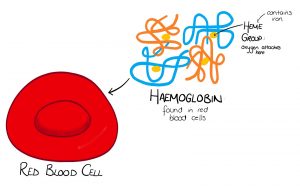 Blood looks red as the haemoglobin absorbs the green and blue wavelengths in light, reflecting only the red back to our eyes, so we see blood as red. The white light that we could shine on haemoglobin will only have the red bit reflecting back to our eyes, meaning only the red cones in your retina will be activated. If you have a small cut on your knee if you have fallen over for example, you will see that any blood coming out is red. If you have ever had a blood test, you will see the blood that has been collected into bottles is red too. Blood is always red because haemoglobin will always absorb the green and blue wavelengths of light but reflect the red back.
Blood looks red as the haemoglobin absorbs the green and blue wavelengths in light, reflecting only the red back to our eyes, so we see blood as red. The white light that we could shine on haemoglobin will only have the red bit reflecting back to our eyes, meaning only the red cones in your retina will be activated. If you have a small cut on your knee if you have fallen over for example, you will see that any blood coming out is red. If you have ever had a blood test, you will see the blood that has been collected into bottles is red too. Blood is always red because haemoglobin will always absorb the green and blue wavelengths of light but reflect the red back.
Why do veins look blue?
If blood is red, why do our veins look blue? Veins themselves are mostly colourless, kind of like a water bottle. So why, unlike a water bottle, can’t we see the redness of the blood that runs inside them? Our veins appearing blue is an optical illusion – we see our veins through layers of skin and fat, which alters how we see the colour. It is this that causes them to look blue.
Looking a bit closer, why does seeing our veins through skin make them look blue rather than orange or another colour? This is because our skin scatters most of the red bit of white light before it can reach the veins, leaving the blue light to reflect back to our eyes which is what we see. Your veins are not at the surface of your skin and how deep below skin and fat they lie can vary, sometimes when you are really cold, you may hardly be able to see your veins at all, compared to when you are really warm, as veins themselves can expand and contract.
As red light has the longest wavelength of all the light we can see, red light can travel further into your skin and body tissues, easily travelling 5-10mm which is how deep your veins are. The red light is absorbed by your tissues whereas the blue light with a shorter wavelength cannot travel so far, so it is reflected back and this is what is picked up by your eyes, making your veins appear blue.
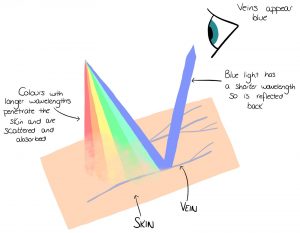
Some animals do have blue blood, however this is rare. Squid and horseshoe crabs have blue blood, as they use haemocyanin instead of haemoglobin to transport the oxygen around the body. Haemocyanin relies on copper instead of iron to bind to oxygen, which appears blue as it reflects the red and green wavelengths, reflecting back only blue light.
